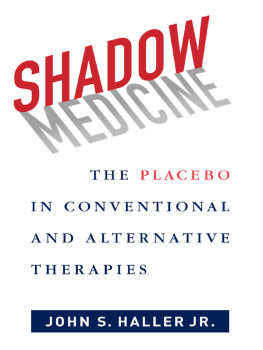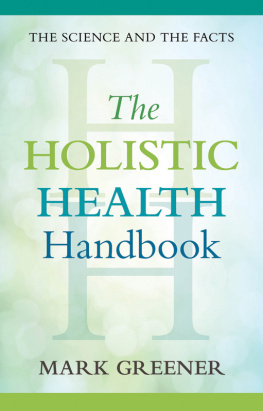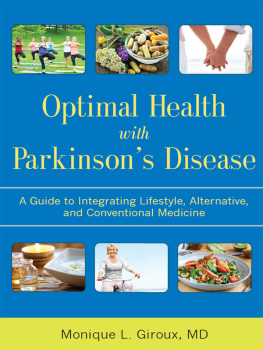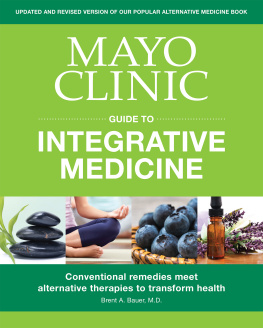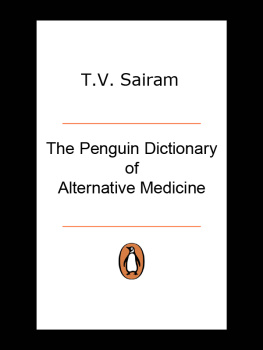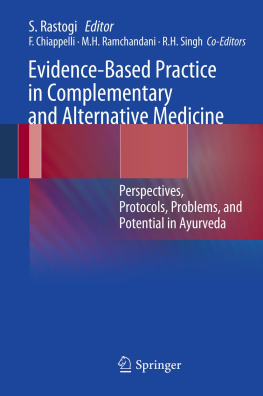SHADOW MEDICINE
JOHN S. HALLER JR.
SHADOW MEDICINE
The Placebo in
Conventional and
Alternative
Therapies
COLUMBIA UNIVERSITY PRESS
NEW YORK
Columbia University Press
Publishers Since 1893
New York Chichester, West Sussex
cup.columbia.edu
Copyright 2014 Columbia University Press
All rights reserved
E-ISBN 978-0-231-53770-4
Library of Congress Cataloging-in-Publication Data
Haller, John S., Jr., 1940 author.
Shadow medicine : the placebo in conventional and alternative therapies / John S. Haller Jr.
Includes bibliographical references and index.
ISBN 978-0-231-16904-2 (cloth : alk. paper) ISBN 978-0-231-53770-4 (ebook)
I. Title. II. Title: Placebo in conventional and alternative therapies. [DNLM: 1. Placebos. 2. Complementary Therapies. 3. Evidence-Based Medicine. 4. Placebo Effect. WB 330]
R733
615.5dc23
2013048051
A Columbia University Press E-book.
CUP would be pleased to hear about your reading experience with this e-book at .
Cover design: Mary Ann Smith
References to websites (URLs) were accurate at the time of writing. Neither the author nor Columbia University Press is responsible for URLs that may have expired or changed since the manuscript was prepared.
For Clio,
my feline companion
and ever-present muse
There is no alternative medicine. There is only scientifically proven, evidence-based medicine supported by solid data or unproven medicine, for which scientific evidence is lacking.
Phil B. Fontanarosa and George D. Lundberg, Alternative Medicine Meets Science (1998)
The only solid piece of scientific truth about which I feel totally confident is that we are profoundly ignorant about nature. It is this sudden confrontation with the depth and scope of ignorance that represents the most significant contribution of twentieth-century science to the human intellect.
Lewis Thomas, The Medusa and the Snail (1979)
CONTENTS
S pecial thanks go to Michael Flannery, professor and associate director for historical collections at the Lister Hill Library at the University of Alabama at Birmingham; Dennis B. Worthen, former Lloyd Scholar at the Lloyd Library and Museum in Cincinnati; Kyle Perkins, associate dean for academic affairs at Florida International University; and Marc Katchen and Debra Katchen, who gave generously of their time for support and guidance. My gratitude extends as well to Columbia University Press editor Patrick Fitzgerald, assistant editor Bridget Flannery-McCoy, copyeditor Annie Barva, and the presss anonymous reviewers, all of whom saw merit in my approach not to lay waste one side or the other in the ongoing feud between proponents of evidence-based medicine and those supporting unconventional therapies. Others to whom I am indebted include former colleagues David Werlich, John Dotson, Howard Allen, Mark Foster, Don Rice, and David Wilson; the librarians and staff of the Lloyd Library and Museum in Cincinnati, the Morris Library of Southern Illinois University at Carbondale, the Southern Illinois University School of Medicine in Springfield, the National Library of Medicine, Boston Medical Library, Harvard College Library, the Francis A. Countway Library of Medicine at Harvard Medical School, the John Crerar Library of Chicago, the New York Academy of Medicine Library, New York Public Library, Northwestern University, the Stanford University Library, the University of Illinois Library at Champaign-Urbana, the University of Wisconsin Library, the University of Kansas Library, the University of Michigan Library, the Yale University Cushing/Whitney Medical Library, Google Books, and JSTOR.
As always, I am grateful to my wife, Robin, who offered inspiration, encouragement, criticism, and substantial assistance, including the reading of numerous drafts and the indexing of the book. Those errors of fact or interpretation that remain are mine alone.
| AIDS | acquired immunodeficiency syndrome |
| CAM | complementary and alternative medicine |
| EBM | evidence-based medicine |
| FDA | US Food and Drug Administration |
| HIV | human immunodeficiency virus |
| IOM | Institute of Medicine |
| NCCAM | National Center for Complementary and Alternative Medicine |
| NIH | National Institutes of Health |
| OAM | Office of Alternative Medicine |
| RCT | randomized clinical trial |
C onsider for a moment these varying scenes: a graduate of Barbara Ann Brennans School of Healing draws upon the forces in the universe to balance the multilayered fields of aura emanating from a patient; a homeopath, after a lengthy consultation, treats the symptoms of alopecia with sulfur serially diluted and succussed to 30C to release its dynamized energies; a nurse creates an energy exchange using therapeutic touch to restore a patients self-healing abilities; and, finally, a chiropractor applies spinal manipulative therapy to treat a child with attention deficit hyperactive disorder. Each of these modalities is representative of unconventional healing practices common across the United States. Whereas reductionist biomedicine draws its authority from the randomized clinical trial (RCT) and laws embedded in the natural sciences, these and other unconventional therapies rely on a philosophy of organism known as vitalism, which explains life not by the laws of physics and chemistry, but by a principle, force, or spiritlike power that comes from beyond the material world to animate organic matter.
Serving as a counterforce to conventional medicines reliance on academically trained physicians whose therapies are based principally on the materia medica (pharmacopoeia), unconventional medicine chooses a healing encounter that defines health in a psychological and spiritual manner attuned to notions of patient individualization and self-healing. Scarcely hidden in this encounter is a significant change in the healers role. Rather than someone with access to rational scientific knowledge, training, and competence in special skill sets, the unconventional healer is someone who relies on intuitive insight and at the same time encourages a more egalitarian relationship with his or her patientsreplacing reductionist thinking with notions of spirituality, meditation, insight, attitude, and behavioral modification. In this new setting, the patients experience becomes intensely personal and compares strikingly to certain types of spiritual awakening outside the material world of reductionist science.
Overtly metaphysical in their view of the causal forces, unconventional healers conceive of a spiritual encounter that includes the individuals inner capacity to find harmony with nature. This has become the countervailing voice of unconventional medicine in its stand against the medical establishment with its empirically tested system of medicine. For unconventional medicine, nonmaterial (paranormal) agents work in unison with the body to achieve an inner harmony. In sharp contrast to orthodox medicine, it encourages practitioners to exercise their metaphysical imaginations, identifying with a thinly veiled vitalism that not only reduces the universe to a single set of governing principles but articulates a philosophy that aligns the patients recuperative powers with providential laws and purposes.

